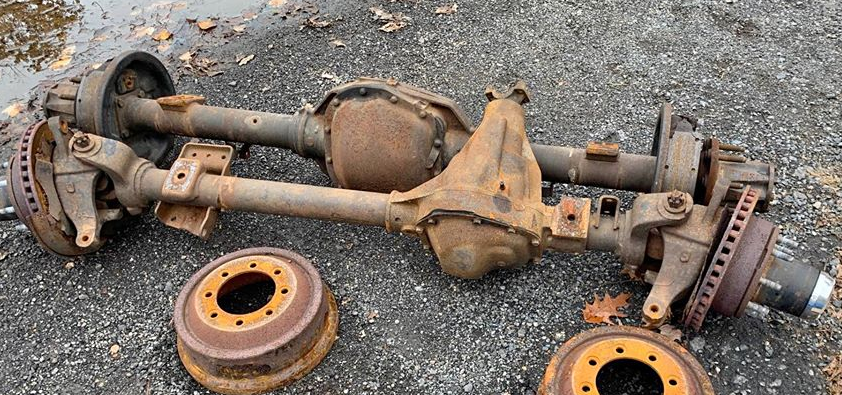The Dana 60 Axle: Everything Bullnose Truck Owners Need to Know

The Dana 60 axle is a name that carries weight in the world of trucks and off-roading. Renowned for its strength and durability, this axle has become a staple in heavy-duty builds and serious off-road rigs. Whether you’re driving a 1980-1986 Bullnose Ford truck or considering an upgrade, this guide will cover everything you need to know about the Dana 60 axle. From its history and technical specs to its strengths, maintenance, and how it stacks up against other axles, this article is your one-stop resource.
Overview of the Axle
History
- The Dana 60 was introduced by Dana Spicer in the mid-1950s, designed to handle the increased power and weight of heavier trucks. Over the decades, it’s become the go-to axle for heavy-duty trucks, both in the front and rear axle configurations. Its reputation for strength and reliability has made it a favorite for everything from military vehicles to off-road rigs.
Applications
- The Dana 60 was used in various configurations across many different vehicles, including Ford, Dodge, and GM trucks. In the Bullnose Ford trucks, the Dana 60 was often found in F-250 and F-350 models, especially those intended for towing and heavy-duty use. It’s also a popular swap for those looking to upgrade the strength of their F-150 or Bronco.
Technical Specifications
Axle Type
- The Dana 60 is available in both front and rear axle configurations. As a solid axle, it’s built to withstand significant stress, making it ideal for off-road and heavy-duty applications. The front axle version typically comes with kingpin or ball joint knuckles, while the rear axle is a full-floating design, meaning the weight of the vehicle is carried by the axle housing rather than the axle shafts themselves.
Axle Shaft Splines
- Dana 60 axles commonly feature 30 or 35 spline axle shafts, with the 35-spline version offering superior strength. These heavy-duty splines are a key reason why the Dana 60 is favored in high-torque applications. The increased spline count means more contact area, reducing the likelihood of twisting or snapping under load.
Ring Gear Size
- The ring gear in a Dana 60 measures 9.75 inches in diameter. This larger ring gear allows the axle to handle more torque, making it suitable for vehicles with large engines or those used for heavy towing. The size of the ring gear is one of the reasons the Dana 60 is considered nearly indestructible under normal use.
Gear Ratios
- The Dana 60 offers a wide range of gear ratios, from 3.31:1 to 7.17:1. This range makes it versatile enough for both highway cruising and extreme off-roading. Lower gear ratios (numerically higher) like 4.88:1 or 5.38:1 are favored for off-road use, where torque multiplication is crucial, while higher ratios (numerically lower) are better for on-road fuel efficiency.
Weight Rating
- The gross axle weight rating (GAWR) typically ranges from 5,500 to 7,000 pounds, depending on the specific configuration and application. This high weight rating makes it suitable for heavy-duty trucks that need to carry or tow substantial loads.
Dimensions
- The width of a Dana 60 axle can vary depending on the vehicle it was originally installed in, but it typically ranges from 67 to 69 inches, flange to flange. The axle tubes are often 3.5 inches in diameter, providing the necessary strength for demanding applications.
Axle Weight
- The Dana 60 is a hefty axle, with the front version weighing around 450 pounds and the rear around 300 pounds. This weight is a reflection of the axle’s beefy construction, which contributes to its durability but also means it can impact fuel economy and handling.
Fluid Capacity
- The Dana 60 typically requires about 3 to 4 quarts of gear oil, depending on the specific model and whether it’s a front or rear axle. Proper lubrication is critical for the longevity of this axle, particularly if it’s used in heavy-duty or off-road environments.
Knuckle Type (Front Axle)
- Front Dana 60 axles are known for their durable knuckle designs, with early models using kingpins and later models using ball joints. Kingpin knuckles are often preferred in off-road circles due to their robustness, while ball joints offer easier maintenance and slightly better steering precision.
Full-Floating Design (Rear Axle)
- The rear Dana 60 is a full-floating axle, meaning the axle shafts only drive the wheels and don’t bear the vehicle’s weight. This design is more robust than semi-float axles and is ideal for heavy loads and severe service conditions, making it a favorite for towing and off-road use.
Strengths and Capabilities
Durability
- The Dana 60’s durability is legendary. It’s built to take abuse, whether you’re crawling over rocks, hauling a trailer, or just putting down a lot of power. The heavy-duty construction, including thick axle tubes and large ring gear, means this axle can handle just about anything you throw at it.
Aftermarket Support
- The Dana 60 has one of the most extensive aftermarket support networks of any axle. Whether you’re looking for upgraded gears, lockers, axle shafts, or even custom housings, there’s no shortage of options. This makes it easy to tailor the Dana 60 to your specific needs, whether that’s improved off-road performance or enhanced durability for towing.
Versatility
- The Dana 60 is versatile enough to be used in a wide range of applications. It’s strong enough for heavy-duty trucks and capable enough for hardcore off-road rigs. Whether you’re driving on the street, towing, or off-roading, the Dana 60 can be built to handle it.
Common Upgrades
- Popular upgrades include installing a locking differential for improved traction, upgrading to 35-spline axle shafts for increased strength, and swapping in higher or lower gear ratios depending on your driving needs. Beefier axle tubes and high-steer knuckles are also common in off-road builds.
Compatibility
- The Dana 60 is compatible with a variety of brake setups, including both disc and drum brakes. It also works well with different suspension systems, which makes it a popular choice for custom builds and retrofits. If you’re upgrading from a lighter axle, be prepared to make some adjustments to fit the Dana 60, but the benefits will be worth it.
Maintenance and Care
Fluid Recommendations
- Dana recommends using 75W-90 or 80W-90 gear oil, depending on the specific model and usage. If you’re running a limited-slip or locking differential, make sure to add the appropriate friction modifier to prevent chatter and ensure smooth operation.
Regular Maintenance
- Regular maintenance is key to keeping your Dana 60 in top shape. This includes changing the gear oil every 30,000 to 50,000 miles, checking the axle seals for leaks, and inspecting the bearings for wear. Given the heavy-duty nature, it’s also a good idea to check the axle tubes and knuckles for any signs of stress or damage, especially if you use your truck for off-roading or heavy towing.
Common Issues
- The Dana 60 is robust, but like any axle, it can develop issues. Common problems include worn bearings, particularly in high-mileage axles, and leaks from the pinion seal. If you notice any unusual noises, like a whine or grind from the axle, it’s important to inspect the internals to prevent more serious damage.
Tips for Longevity
- To maximize the lifespan of your Dana 60, follow the recommended maintenance schedule and avoid overloading your vehicle. Regular inspections of the seals, bearings, and gear oil level will go a long way in preventing major issues. If you’re off-roading, be mindful of the terrain and avoid high-impact situations that could damage the axle.
Comparison with Other Axles
Strength vs. Competitors
- The Dana 60 is often compared to other heavy-duty axles, like the Dana 44 or Ford 9-inch. While the Dana 44 is lighter and less expensive, the Dana 60 is stronger and more suited to severe-duty applications. Compared to the Ford 9-inch, the Dana 60 offers better durability in front axle applications and is generally more robust in off-road scenarios.
Ideal Applications
- The Dana 60 is ideal for trucks that need to handle heavy loads, tough terrain, or high power levels. If you’re building a Bullnose truck for off-roading, towing, or just want a bulletproof axle, the Dana 60 is an excellent choice.
Installation Notes
Compatibility and Modifications
- Installing a Dana 60 in a Bullnose truck may require some modifications, particularly if you’re upgrading from a lighter axle. You’ll need to ensure that the driveshaft, suspension, and brake systems are compatible with the Dana 60’s dimensions and weight. It’s also worth considering the added weight of the axle and how it might affect your truck’s handling and fuel economy.
Brake and Suspension Considerations
- If you’re upgrading, you might also consider upgrading your brakes and suspension. The increased strength and weight of the Dana 60 can put additional strain on your truck’s braking system, so disc brakes are often a good match. Suspension upgrades, such as stronger leaf springs or reinforced control arms, can help manage the extra weight and ensure your truck handles well on and off the road.
Frequently Asked Questions (FAQ)
Q: What makes the axle so strong?
- A: The Dana 60 is built with thick axle tubes, a large ring gear, and heavy-duty bearings, all of which contribute to its strength. The axle’s design allows it to handle high torque loads and withstand the stresses of off-roading and towing.
Q: How does the Dana 60 compare to the Dana 44?
- A: The Dana 60 is significantly stronger than the Dana 44, making it better suited for heavy-duty and extreme off-road applications. However, the Dana 44 is lighter and more affordable, which can make it a better choice for less demanding setups.
Q: Can I swap a Dana 60 into my Bullnose F-150?
- A: Yes, swapping a Dana 60 into a Bullnose F-150 is a popular upgrade for those looking to increase their truck’s strength and durability. The swap may require modifications to the suspension, driveshaft, and brake system, but it’s a well-documented upgrade.
Q: What gear ratio should I choose?
- A: The best gear ratio depends on your intended use. Lower ratios like 4.88:1 are ideal for off-roading and towing, while higher ratios like 3.73:1 offer better fuel economy for highway driving.
Q: Is the Dana 60 compatible with disc brakes?
- A: Yes, the Dana 60 is compatible with disc brakes. In fact, many aftermarket upgrades for the Dana 60 include disc brake conversions, which can improve braking performance, especially in off-road or heavy-duty applications.
Q: How often should I change the gear oil?
- A: It’s recommended to change the gear oil every 30,000 to 50,000 miles, depending on your driving conditions. If you’re using the axle for heavy towing or off-roading, consider changing the oil more frequently.
Q: What’s the best way to increase the strength?
- A: To increase the strength of your Dana 60, consider upgrading to 35-spline axle shafts, using a high-quality locker, and installing reinforced axle tubes or trusses. These upgrades can help the axle withstand more abuse in extreme conditions.
Q: Are there any common issues I should watch out for?
- A: Common issues include worn bearings and pinion seal leaks, particularly in high-mileage or heavily-used axles. Regular maintenance and inspections can help prevent these problems from becoming serious.
Conclusion

The Dana 60 axle is a powerhouse, offering unrivaled strength and durability for heavy-duty and off-road applications. Whether you’re building a Bullnose truck for off-roading, towing, or simply want an axle that can handle serious abuse, the Dana 60 is an excellent choice. With proper maintenance and a few well-chosen upgrades, this axle will keep your truck performing at its best for years to come.

If you want more specific information on Bullnose Ford Trucks, check out my YouTube Channel!
For more information on Bullnose Fords, you can check out the BullnoseFord SubReddit or Gary’s Garagemahal. Both are excellent resources.